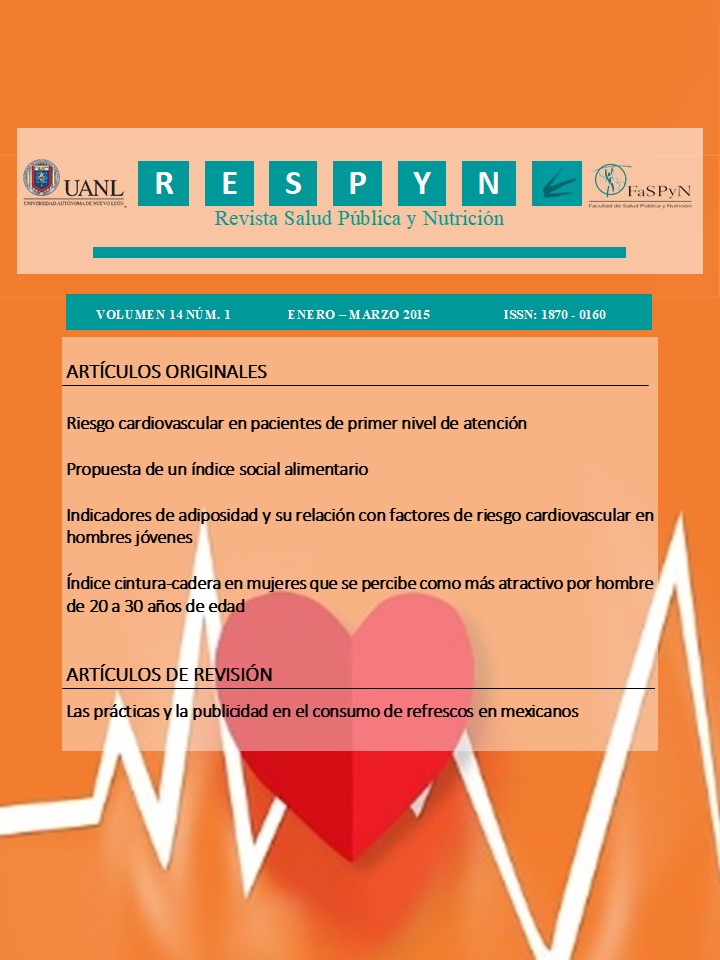RIESGO CARDIOVASCULAR EN PACIENTES DE PRIMER NIVEL DE ATENCIÓN
Abstract
Introducción: Las enfermedades cardiovasculares (ECV) en México constituyen la primera causa de muerte. En el primer nivel de atención no se detecta el Riesgo Cardiovascular (RCV) de los pacientes de manera sistemática y pasan desapercibidas por el personal de salud. Objetivo: Establecer la prevalencia en RCV en la población de una Unidad de primer nivel de atención de una institución de seguridad social. Material y Métodos: Diseño de estudio transversal en pacientes de 30 a 74 años de edad n=269. Se consideraron variables socios demográficos, antropométricos, de factores de RCV y perfil bioquímico. El plan de análisis consistió en estadística descriptiva (medidas de tendencia central y de dispersión) e inferencial (X2, prueba de T y Riesgo Relativo). Resultados: El promedio de edad fue 51.4±12 años, eran hombres en el 49.9%, casados 75%. La prevalencia de RCV alto fue de 21.6%, sobrepeso y obesidad en el 58.7% de la población y factores de RCV modificables principalmente en hombres. En la prueba de t , se encontró diferencia entre género únicamente en VLDL (.005) y en la X2 en la mayoría de las variables estudiadas. El promedio de RR en esta población fue 2.4±1.9. Conclusión: La prevalencia de RCV fue mayor a la encontrada en otros estudios y se observa una alta prevalencia de factores de RCV en el grupo de estudio. Se recomienda el apego a las Guías Diagnóstico Terapéuticas y tabuladores de RCV por el médico familiar para identificar oportunamente grupos de riesgo
ABSTRACT
Introduction Cardiovascular disease (CVD) in Mexico are the lead cause of death. In primary care, cardiovascular risk (RCV) patients are not detected unnoticed systematically. Objective: To establish prevalence on the population of a primary care unit an social security institution. Material and Methods: Transversal study design in patients 30 to 74 years n = 269. Demographic variables, anthropometric, cardiovascular risk factors and socio biochemical profile were considered. The analysis plan consisted of descriptive statistics (measures of central tendency and dispersion) and inferential (X2, T test and Relative Risk). Results: The mean age was 51.4 ± 12 years, 49.9% were men, 75% married. The prevalence of high cardiovascular risk was 21.6%, overweight and obesity in 58.7% of the population and largely modifiable cardiovascular risk factors in men. In the t test, differences were found between gender only VLDL (.005) and X2 in most of the variables studied. The average RR in this population was 2.4 ± 1.9. Conclusions: The prevalence of cardiovascular risk was higher than found in other studies and a high prevalence of cardiovascular risk factors in the study group were observed. It is recommended attachment to the Guidelines Diagnostic and Therapeutic RCV tabs by the family physician to quickly identify risk groups.
Palabras clave: Riesgo cardiovascular, factores de riesgo, atención primaria, cardiovascular risk, risk factors, primary care
Downloads
References
Escobedo de la Peña J, Perez R de J, Schargrodsky H Champagne B. Prevalencia de dislipidemias en la ciudad de Méxio y su asociación con otros factores de riesgo cardiovascular. Resultados del estudio CARMELA. Gaceta Médica de México. 2014; 150: 128-36
Fanghanel-Salomon G, Velázquez-Monroy O, Lara-Esqueda A et. Al. Epidemiología cardiovascular en México. Estudio comparativo entre datos nacionales y una población cautiva de trabajadores en el Distrito Federal. Salud Pública Mex 2007; 49(2):83-85.
O’ Donel C, Elosua R, Factores de riesgo cardiovascular. Perspectivas derivadas del Framinghan Heart Study. Rev Esp Cardiol. 2008;61:299-310.
Chobaniam AV, Bakris GL, Black HR, Cushman WC, Green LA, Izzo JL, Jones DW, Materson BJ, Oparil S, Wright JT, Roccella EJ, and the National High Blood Pressure Education Program Coordinating Committee. The Seventh Report of the Joint National Committee on Prevention, Detection, Evaluation, and Treatment of High Blood Pressure. The JNC 7 Report. JAMA 2003;(289):2560-2572.
Manton KG, Woodbury MA, Stallard E. Analysis of the components of CHD risk in the Framingham study: new multivariate procedures for the analysis of chronic disease development. Comput Biomed Res. 1979; 12:109-23.
Villar Alvarez, F, La Prevención cardiovascular en España: Promoviendo el uso de las recomendaciones. Rev. Esp. Salud Pública. 2004:78 (4) 421-434.
Martínez A, Chávez R. Prevalencia y comorbilidad de Dislipidemias en el primer nivel de atención, Rev. Med IMSS 2007; 45(5): 469-475.
Olaiz-Fernández G, Rivera-Dommarco J, Shamah-Levy T, Rojas R, Villalpando-Hernández S, Hernández-Avila M, Sepúlveda-Amor J. Encuesta Nacional de Salud y Nutrición 2012. Cuernavaca, México: Instituto Nacional de Salud Pública, 2012.
Kuri-Morales P, González-Roldán J, Hoy MJ, Cortés-Ramírez Epidemiología del Tabaquismo en México. Salud Pública Mex 2006; 48 (Suppl 1):91-98.
Pérez E, Morales M, Grajales I. Panorama Epidemiológico de la Obesidad en México. Rev Mex Cardiol. 2006; 14 (2): 62-64.
Secretaría de Salud, Dirección General de Epidemiología. Encuesta Nacional de Enfermedades Crónicas, 1993.México, D.F.: SSA, 1993.
Secretaría de Salud. (1987). Reglamento de la Ley General de Salud en Materia de Investigación para la Salud. Recuperado el 03 de abril del 2011, de http://www.salud.gob.mx/unidades/cdi/nom/compi/rlgsmis.html
Downloads
Published
How to Cite
Issue
Section
License
The rights of the work belong to the author or authors, however, by sending it for publication in the Public Health and Nutrition Magazine of the Faculty of Public Health and Nutrition of the Autonomous University of Nuevo León, they grant the right for its first publication in between electronic, and possibly, in print to the Public Health and Nutrition Magazine. The license used is the Creative Commons attribution, which allows third parties to use what is published whenever the authorship of the work is mentioned and the first publication that is in the Public Health and Nutrition Magazine. Likewise, the author or authors will take into account that it will not be allowed to send the publication to any other journal, regardless of the format. The authors will be able to make other independent and additional contractual agreements for the non-exclusive distribution of the version of the article published in the Public Health and Nutrition Magazine (e.g., institutional repository or publication in a book) provided they clearly state that The work was published for the first time in the Public Health Magazine, Magazine of the Faculty of Public Health and Nutrition of the Autonomous University of Nuevo León.










